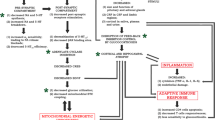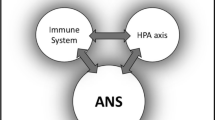Abstract
Previous studies in our laboratory have demonstrated the ability of monoaminergic transplants in the rat frontal cortex to produce antidepressive activity in both the learned helplessness model and the forced swimming test, as well as to increase monoamine levels in the implanted frontal cortex. These findings implicate increased cortical levels of norepinephrine (NE) and serotonin (5-HT) in the antidepressive activity of monoaminergic transplants. The goal of the present study was to characterize the pharmacologic mechanisms involved in the monoaminergic graft-induced antidepressive activity. Immobility scores in the forced swimming test (FST) were assessed after transplantation of 5-HT-containing pineal gland tissue, NE-containing adrenal medullary tissue, a combination of both tissues, or sciatic nerve (control) into the rat frontal cortex and compared to non-transplanted and chronic imipramine-treated rats. Monoaminergic transplants and imipramine treatment significantly reduced immobility scores in the FST in contrast to control transplanted or untreated animals. All groups were assessed pharmacologically with the adrenergic antagonists phentolamine (α) and propranolol (β), and serotonergic antagonists metergoline (5-HT1/5-HT2) and pirenperone (5-HT2). Serotonergic antagonists, particularly the 5HT2 antagonist, blocked the reduction in FST immobility induced by the pineal implants. Adrenergic antagonists not only blocked FST immobility reductions in adrenal medullary grafted animals, but overcompensated for the adrenal transplants, producing a large increase in immobility. The FST reduction induced by pineal and adrenal cografts was blocked by all four monoaminergic antagonists. FST immobility scores in control transplanted and non-transplanted animals were not altered by any of the antagonists. The immobility reduction produced by chronic imipramine treatment was blocked significantly only by propranolol. These results indicate that adrenal medullary and pineal transplants produce sustained antidepressive activity via local interaction withα-andβ-adrenergic receptors or 5HT2 receptors, respectively, and may be mediated by mechanisms distinct from antidepressant drugs.
Similar content being viewed by others

References
Banerjee SP, Kung LS, Riggi SJ, Chanda SK (1977) Development of beta-adrenergic subsensitivity by antidepressants. Nature 288:455–456
Bertler A, Falck B, Owmann C (1964) Studies on the 5-hydroxytryptamine stores in the pineal gland of the rat. Acta Physiol Scand 63:1–18
Blackshear MA, Sanders-Bush E (1982) Serotonin receptor sensitivity after acute and chronic treatment with mianserin. J Pharmacol Exp Ther 221:303–308
Borsini F, Meli A (1988) Is the forced swimming test a suitable model for revealing antidepressant activity? Psycholpharmacology 94:147–160
Borsini F, Bendotti C, Velkov V, Rech R, Saminin R (1981) Immobility test: effects of 5-hydroxytryptaminergic drugs and role of catecholamines in the activity of some antidepressants. J Pharm Pharmacol 33:33–37
Borsini F, Nowakowska E, Pulvirenti L, Samanin R (1985) Repeated treatment with amitriptyline reduces immobility in the behavioral “despair” test in rats by activating dopaminergic andβ-adrenergic mechanisms. J Pharm Pharmacol 37:137–138
Borsini F, Bolterra G, Meli A (1986) Does the behavioral “despair” test measure despair. Physiol Behav 38:385–386
Bryant SG, Brown CS (1986) Current concepts in clinical therapeutics: major affective disorder, part 1. Clin Pharmacol 5:304–318
Caldecott-Hazard S, Morgan DG, DeLeon-Jones F, Overstreet DH, Janowsky D (1991) Clinical and biochemical aspects of depressive disorders: II. Transmitter/receptor theories. Synapse 9:251–301
Cervo L, Grignaschi G, Samanin R (1990) α2-Adrenoceptor blockade prevents the effect of desipramine in the forced swimming test. Eur J Pharmacol 175:301–307
Cervo L, Grignaschi G, Rossi C, Samanin R (1991) Role of central serotonergic neurons in the effect of sertraline in rats in the forced swimming test. Eur J Pharmacol 196:217–222
Charney DS, Menkes DB, Heninger GR (1981) Receptor sensitivity and the mechanism of action of antidepressant treatment. Arch Gen Psychiatry 38:1160–1180
Colpaert FC, Janssen PAJ (1983) The head-twitch response to intraperitoneal injection of 5-hydroxytryptophan in the rat: antagonists effects of purported 5-hydroxytryptamine antagonists and of pirenperone, an LSD antagonist. Neuropharmacology 22:993–1000
Colpaert FC, Niemegeers JE, Janssen PAJ (1982) A drug discrimination analysis of lysergic acid diethylamide (LSD): In vivo agonist and antagonist effects of purported 5-hydroxytryptamine antagonists and of pirenperone, a LSD-antagonist. J Pharmacol Exp Ther 221:206–214
Cooper JR, Bloom FE, Roth RH (1986) The biochemical basis of neuropharmacology. Oxford University Press, New York
Cowen PJ (1990) A role for 5-HT in the action of antidepressant drugs. Pharmacol Ther 46:42–51
Dougherty DD, Sortwell CE, Sagen J (1991) Pharmacologic specificity of reduced immobility in a rodent depression model by monoaminergic neural transplants. Soc Neurosci Abstr 17:51
Dunnett SB, Richards SJ (eds) (1990) Progress in brain research, vol 82, neural transplantation: from molecular basis to clinical applications. Elsevier, New York
Finnegan KT, Terwilliger MM, Berger PA, Hollister LE, Csernansky JG (1987) A comparison of the neurochemical and behavioral effects of clenbuterol and desipramine. Eur J Pharmacol 134:131–136
Gilman AG, Rall TW, Nies AS, Taylor P (1990) Goodman and Gilman's The pharmacological basis of therapeutics. Pergamon, New York
Greenberg A, Zinder O (1982) α- andβ-receptor control of catecholamine secretion from isolated adrenal medulla cells. Cell Tiss Res 226:655–665
Hascoët M, Bourin M, Bradwejn J (1991) Behavioral models in mice. Implication of the alpha noradrenergic system. Prog Neuro/Psychopharmacol Biol Psychiary 15:825–840
Heumann R, Korsching S, Bandtlow C, Thoenen H (1987) Changes of nerve growth factor synthesis in non-neuronal cells in response to sciatic nerve transection. J Cell Biol 104:1623–1631
Kitada Y, Miyauchi T, Kanazawa H, Nakamich H, Satoh S (1983) Involvement of α- andβ 1-adrenergic mechanisms in the immobility-reducing action of desipramine in the forced swimming test. Neuropharmacology 22:1055–1060
Kupfer DJ (1991) Long-term treatment of depression. J Clin Psychiatary 52:28–34
Luttinger D, Freedman M, Hamel L, Ward SJ, Perrone M (1985) The effects of serotonin antagonists in a behavioral despair procedure in mice. Eur J Pharmacol 107:53–58
Mancinelli A, D'Aranno V, Stasi MA, Lecci A, Borsini F, Meli A (1991) Effect of enantiomers of propranolol on desipramine-induced anti-mobility in the forced swimming test in the rat. Pharmacol Res 23:47–50
Morgan PJ, Davidson GR, Lawson W (1989) Evidence for dual adrenergic receptor regulation of ovine pineal function. J Pineal Res 7:175–183
Nair NPV, Sharma M (1989) Neurochemical and receptor theories of depression. Psychiatr J Univ Ottawa 14:328–341
Ortega JA, Sagen J (1993) Pharmacological characterization of opioid peptide release from chromaffin cell transplants using a brain slice perfusion method. Exp Brain Res 95:381–387
Petty F, Sherman AD (1980) Regional aspects of the prevention of learned helplessness by desipramine. Life Sci 26:1447–1452
Plaznik A, Danyssz W, Kostowski W (1984) Behavioral evidence for alpha-1-adrenoceptors up- and alpha-2-adreneoceptor down-regulation in the rat hippocampus after chronic imipramine treatment. Eur J Pharmacol 101:305–306
Pohorecky LA, Wurtman RJ (1971) Adrenocortical control of epinephrine synthesis. Pharmacol Rev 23:1–35
Porsolt RD, LePichon M, Jalfre M (1977) Depression: a new model sensitive to antidepressant treatments. Nature 266:730–732
Porsolt RD, Bertin A, Blavit N, Deniel M, Jalfre M (1979) Immobility induced by forced swimming in rats: effects of agents which modify central catecholamine and serotonin activity. Eur J Pharmacol 57:201–210
Pulvirenti L, Samanin R (1986) Antagonism by dopamine, but not noradrenaline receptor blockers of the anti-immobility activity of desipramine after different treatment schedules in the rat. Pharmacol Res Commun 18:73–80
Quay WB, Halevy A (1962) Experimental modifications of the rat pineal content of serotonin and related indole amines. Physiol Zool 35:1–7
Sagen J, Sortwell CE, Pappas GD (1990a) Monoaminergic neural transplants prevent learned helplessness in a rat depression model. Biol Psychiatry 28:1037–1048
Sagen J, Wang H, Pappas GD (1990b) Adrenal medullary implants in the rat spinal cord reduce nociception in a chronic pain model. Pain 42:69–79
Sagen J, Dougherty D., Sortwell CE, Unnerstall JR (1994) Dissociation between antidepressant effects and monoaminergic receptor changes in rats with monoaminergic transplants in the frontal neocortex. 3rd Int Behav Neurosci Abstr (in press)
Santana C, Guerrero JM, Reiter RJ, Menendez-Pelaez (1989) Role of postsynaptic α-adrenergic receptors in theβ-adrenergic stimulation of melatonin production in the Syrian hamster pineal gland in organ culture. J Pineal Res 7:13–22
Siever LJ, Davis KL (1985) Overview: toward a dysregulation hypothesis of depression. Am J Psychatry 142:1017–1031
Sortwell CE, Sagen J (1993) Induction of antidepressive activity by monoaminergic transplants in rat neocortex. Pharmacol Biochem Behav 46:225–230
Sulser F (1983) Mode of action of antidepressant drugs. J Clin Psychiat 44:14–20
Sulser F, Vetulani J, Mobley PI (1978) Mode of action of antidepressant drugs. Biochem Pharmacol 27:257–261
Svenson TH, Usdin T (1978) Feedback inhibition of brain noradrenaline neurons by tricyclic antidepressants: alpha-receptor mediation. Science 202:1089–1091
Syvalahti E (1987) Monoaminergic mechanisms in affective disorders. Med Biol 65:89–96
Tallarida RJ, Murray RB (1987) Manual of pharmacologic calculations with computer programs, 2nd edn. Springer, New York Berlin Heidelberg
Tollefson GD (1991) Antidepressant treatment and side effect considerations. J Clin Psychiatry 52:4–13
Wakade AR, Malhotra RK, Wakade TD, Dixon WR (1986) Simultaneous secretion of catecholamines from the adrenal medulla and of [3H]norepinephrine from sympathetic nerves from a single test preparation: Different effects of agents on the secretion. Neuroscience 18:877–888
Walmsley JK, Byerley WF, McCabe RT, McCabe RT, McConnell EJ, Dawson TM, Grosser BI (1987) Receptor alterations associated with serotonergic agents: an autoradiographic analysis. J Clin Psychiatry 48:19–25
Wieland S, Lucki I (1990) Antidepressant-like activity of 5-HT1A agonists measured with the forced swim test. Psychopharmacology 101:497–504
Willner P (1985) Depression: a psychobiological synthesis. Wiley, New York
Wurtman RJ, Axelrod J (1966) Control of enzymatic synthesis of adrenaline in the adrenal medulla by adrenal corticalsteroids. J Biol Chem 241:2301–2305
Wurtman RJ, Axelrod J, Kelly DE (1968) The pineal. Academic Press, New York
Author information
Authors and Affiliations
Rights and permissions
About this article
Cite this article
Dougherty, D.D., Sortwell, C.E. & Sagen, J. Pharmacologic specificity of antidepressive activity by monoaminergic neural transplants. Psychopharmacology 118, 10–18 (1995). https://doi.org/10.1007/BF02245244
Received:
Revised:
Issue Date:
DOI: https://doi.org/10.1007/BF02245244



